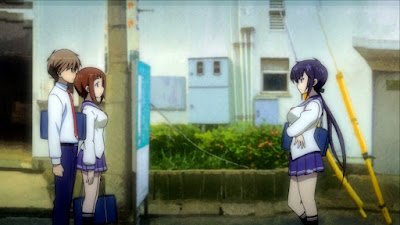Why does manga cost more in the USA? (compared to Japan)
The manga market has a remarkable boom only a couple of years ago before our economic downturn. Amidst all the discussion in anime forums about improving the position of the manga market is the suggestion of lowering the price to Japanese levels. While there is truth to the statement that lowering the price to Japanese levels would increase the volume sales of manga in the USA, there are many things in play that keeps the price of manga higher in the United States. The reason why manga is more expensive in the USA are licensing costs, economies of scale, distribution costs, paper quality, and paper size. All these factors combined means that manga is more expensive in the USA than in Japan.
 |
| One of my favorite Viz Licenses |
When there are discussions about the disparity of manga prices in Japan in the USA, licensing costs are typically lost in the argument. When manga is sold in the USA, it needs to be licensed by the Japanese publisher. When a license is made, there are terms of the contract like the cost of the license along with the length of the license. A license to an American publisher means that it is a fixed cost. Before a single volume of manga is sold, the American publisher already has a fixed cost to deal with. Remember this, American Manga publishers need to make money to survive, so all the licensing costs are passed to the consumer.
There is also the other factor of what kind of franchises get licensed in the USA. Typically the franchises that get an American release are the popular, more mainstream series. This means that the Japanese publisher also demands a premium when it comes to licensing costs. It is difficult to negotiate the licensing costs downward because the Japanese companies know that what is being licensed are the popular series that have more chances of success in the USA.
Economies of Scale
It is a lesson taught in business school many times, economies of scale drives down the cost of production. When a manga is made, there are fixed costs in the production of it because of the machinery, the ink, the paper. When you make more of the product, the costs go down because the machine could keep running and bulk purchases of materials are cheaper. It is much cheaper for Viz Media and Yen Press to buy 10 rolls of paper as opposed to buying one roll of paper. The scale of production in Japan and the USA are vastly different. An example of that is the massive 3,200,000 copy print run of One Piece #59 [1]. While One Piece is an outlier in Japan in terms of sales, the Japanese top 30 sales normally bottom out at around 20,000 [2]. In America, a manga that sells 20,000 in one week is incredible sales. When the sales of manga in the USA start increasing, American publisher can start taking advantage of economies of scale.
Another problem is the ubiquity of scanlations which affects the sales of the American market, which in turn means that the American publishers will get less money. In turn they will cut staff and release less manga in the USA. When the release less manga, they are not taking advantage of the economies of scale and the price per volume increases. If the American market continues to be plagued by scanlations, expect the price of manga to continue to rise because they are not taking advantage of economies of scale.
 |
| Factory printing, it isn't glamorous |
Distribution Costs in the USA
Distribution adds costs to whatever product you buy because each customer in the supply chain needs to make money or it becomes infeasible to sell the product. Before any business majors go in here and point out that Japan has the most expensive distribution system in the world [3]. Allow me to give my argument why distribution costs affect the manga market in the states. Manga sells a small amount compared to books in the USA. It is a niche market whose product lines can only be sold at specialty stores. This means that the cost of shipping a volume of manga is higher than it should be, because of the limited market saturation and a small number of retailers who will order the product. If the American Publishers were to reach economies of scale, it would lower the per volume shipping costs of a volume of manga and move the market past the specialty niche it is in. Then you add the sheer size of the United States compared to Japan, which includes delivery cost in smaller shipment and higher prices since the delivery vehicle would need to make more stops. Then it makes sense that Distribution Costs plays a defining a role in the price of manga.
Paper Size and Quality
 |
| One Piece #59, the record print |
The difference between Japan and the USA is also on the physical volume of manga itself. Each Japanese volume of manga has a dust jacket that covers the manga, but the costs are minimal to produce it since the inside cover is very minimalistic (for example: the humorous panels in Hayate no Gotoku). In Japan, many of the color inserts are released in grayscale. In the USA, they include color pages in many releases. The color pages cost quite a bit to print because they use a different printer (and different quality paper) than the regular manga. This jacks up the cost because many American manga fans are used to color pages thus the Manga publisher release color pages, even if it is not found in the original Japanese manga.
In Conclusion
There are a myriad of reasons why manga costs more in the USA compared to Japan. Licensing costs add a fixed cost for manga companies that adds a baseline cost for every single volume licensed and produced in the USA. Economies of Scale means that the cost of production will always be lower in Japan. The distribution costs to transport manga across this massive country means that manga will always have a premium in the states. Japanese manga also has smaller paper and lower quality paper for printing. All of them add up to show why does manga cost more in the USA than Japan. If we can lower costs by improving any of them then the manga companies can lower the price of manga, which in turn can expand the manga market further.
Special Thanks to Dr. Darold Higa who critiqued the article and gave suggestions to further improve it. If you have any questions or would like to made any additions or challenges to this, contact me and let me know.
Sources Cited
1. "News: One Piece #59 Manga Gets Record 3.2-Million Print Run" Anime News Network. 6 Aug 2010. <http://www.animenewsnetwork.com/news/2010-08-06/one-piece-no.59-manga-gets-record-3.2-million-print-run>
2. "News: Japanese Comic Ranking, December 20-26" Anime News Network. 29 Dec 2010. <http://www.animenewsnetwork.com/news/2010-12-29/japanese-comic-ranking-december-20-26>
3. Lamb, Hair, and McDaniel. The Essnetials of Marketing: 6th edition. <Link>
4. "Japanese Papers for Printing" EDS Inc. 15 Jan 2004 <http://www.edsebooks.com/paper/jpaper.html>






Comments